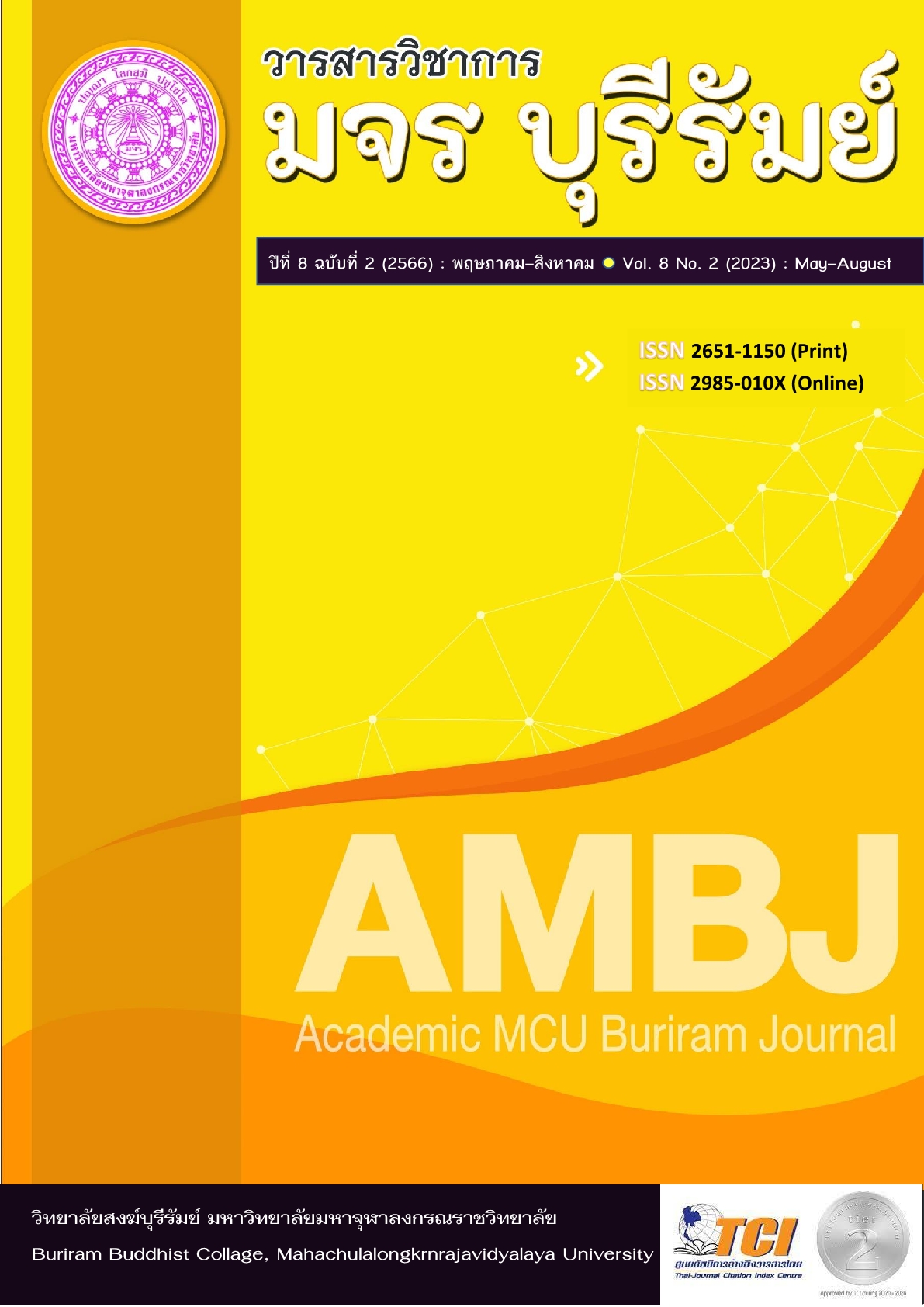Problem-Based Learning Management Study with KWDL Technique Problems of Addition, Subtraction, Multiplication, Division of People of 4th Grade
Keywords:
Problem Solving, Problem-based Learning Management, KWDL TechniqueAbstract
The purpose of this research were: 1) to compare the achievement of mathematics on the problem of addition, subtraction, multiplication, division 4th grade students before and after learning using problems-based learning in combination with KWDL techniques. 2) to examine the satisfaction of 4th grade students regarding the use of problems-based learning with KWDL techniques in teaching addition, subtraction, multiplication, and division word problems. The sample group used in this research consists of 27 from Class 4/2 at Ban Jianpattana School, Khao Saming District, Trat Province, under the supervision of the Trat Primary Educational Service Area Office. The study was conducted during the second semester of the 2565 academic year, select by cluster random sampling, with the classroom serving as the unit of randomization. The research tools used in this study consist of: 1) the problems-based learning lesson plans for teaching problem-solving in addition, subtraction, multiplication, and division word problems using the KWDL technique for 4th grade students. 2) Pre-test and post-test measurement instruments to assess the learning outcomes of the 4th grade students, with a reliability of 0.84. 3) Satisfaction survey questionnaire to measure the students' satisfaction with the teaching approach of problem-solving in addition, subtraction, multiplication, and division word problems using the KWDL technique for 4th grade students. The statistical analysis used for data interpretation includes calculating the mean and standard deviation.
The research results found that:
The sample group of 27 students, after receiving the teaching intervention using problems-based learning with the KWDL technique, showed a statistically significant increase in their average post-test scores เรียน (= 15.44) compared to their average pre-test scores เรียน (
= 7.30) at a significance level of .05. Additionally, the students expressed a high level of satisfaction with the teaching approach, (
= 4.47)
References
เจนจิรา เครือทิวา. (2561). การศึกษาความสามารถในการคิดวิเคราะห์และผลสัมฤทธิ์ทางการเรียน เรื่องแสงของนักเรียนชั้นมัธยมศึกษาปีที่ 2 ด้วยการจัดการเรียนรู้ แบบสืบเสาะหาความรู้ (5E) ร่วมกับเทคนิค KWDL. วารสารสาขามนุษยศาสตร์ สังคมศาสตร์ และศิลปะ มหาวิทยาลัยศิลปากร. 11(2), 1138-1154.
ฉันทกานต์ สวนจันทร์. (2564). การพัฒนาความสามารถในการแก้ปัญหา โดยใช้กิจกรรมการเรียนรู้ปัญหาเป็นฐาน เรื่อง ความปลอดภัยในชีวิต กลุ่มสาระการเรียนรู้สุขศึกษาและพลศึกษา ของนักเรียนชั้นมัธยมศึกษาปีที่ 2. วารสารวิชาการมหาวิทยาลัยการจัดการและเทคโนโลยีอีสเทิร์น, 18(1), 57-68.
ดุษฎี โยเหลา และ คณะ. (2557). การศึกษาการจัดการเรียนรู้แบบ PBL ที่ได้จากโครงการสร้างชุดความรู้เพื่อสร้างเสริมทักษะแห่งศตวรรษที่ 21 ของเด็กและเยาวชน: จากประสบการณ์ความสำเร็จของโรงเรียนไทย. กรุงเทพมหานคร: หจก. ทิพยวิสุทธิ์
บุญเลี้ยง ทุมทอง. (2556). ทฤษฎีและการพัฒนารูปแบบการจัดการเรียนรู้ (Theories and development instructional model). กรุงเทพฯ: โรงพิมพ์เอสพริ้นติ้ง ไทย แฟคตอรี่.
เบญจลักษณ์ ภูสามารถ. (2563). การพัฒนาความสามารถในการแก้โจทย์ปัญหาคณิตศาสตร์ โดยใช้กิจกรรมการเรียนรู้เทคนิค KWDL ของนักเรียนชั้น ประถมศึกษาปีที่ 5. วิทยานิพนธ์ครุศาสตรมหาบัณฑิต สาขาวิชาหลักสูตรและการเรียนการสอน. มหาวิทยาลัยราชภัฎมหาสารคาม.
ปัทมาวรรณ ดวงจันทร์. (2562). การพัฒนาผลการจัดการเรียนรู้เรื่อง การคูณ ของนักเรียนชั้นประถมศึกษาปีที่ 4 ที่จัดการเรียนรู้โดยใช้สมองเป็นฐาน (BBL) ร่วมกับเทคนิค KWDL. วิทยานิพนธ์ครุศาสตรมหาบัณฑิต สาขาวิชาหลักสูตรและการสอน. มหาวิทยาลัยราชภัฏอุตรดิตถ์.
ภัทราวดี มากมี. (2554). การเรียนรู้โดยใช้ปัญหาเป็นฐาน (Problem-based Learning). วารสารวิชาการมหาวิทยาลัยอีสเทิร์นเอเชีย, 1(1), 7-14.
ยุวดี ศรีสังข์. (2564). การพัฒนาแบบฝึกทักษะคณิตศาสตร์โดยใช้เทคนิค KWDL เพื่อส่งเสริมความสามารถในการแก้ปัญหา เรื่อง ร้อยละ สำหรับนักเรียนชั้นประถมศึกษาปีที่ 5. วารสารศึกษาศาสตร์ มหาวิทยาลัยบูรพา, 32(1), 32-45.
รุสดา จะปะเกีย. (2557). ผลของการจัดการเรียนรู้แบบใช้ปัญหาเป็นฐาน ที่มีต่อผลสัมฤทธิ์ทางการเรียนชีววิทยา และความพึงพอใจในการจัดการเรียนรู้ ของนักเรียนชั้นมัธยมศึกษาปีที่ 6. วิทยานิพนธ์ศึกษาศาสตรมหาบัณฑิต สาขาวิชาหลักสูตรและการสอน. มหาวิทยาลัยสงขลานครินทร์.
วทัญญู สุวรรณประทีป. (2561). การพัฒนารูปแบบการจัดการเรียนรู้โดยใช้กรณีศึกษาเป็นฐานร่วมกับปัญหาเป็นฐานและแนวคิดห้องเรียนกลับด้าน เพื่อเสริมสร้างความสามารถ ในการแก้ปัญหาอย่างสร้างสรรค์ สำหรับนักเรียนชั้นมัธยมศึกษาปีที่ 4. วารสารวิชาการมหาวิทยาลัยราชภัฏเพชรบุรี, 8(2).
วัชรา เล่าเรียนดี. (2554). รูปแบบและกลยุทธ์การจัดการเรียนรู้ เพื่อพัฒนาทักษะการคิด. พิมพ์ครั้งที่ 7 (ฉบับปรับปรุง). นครปฐม: คณะศึกษาศาสตร์ มหาวิทยาลัยศิลปากร.
สำนักงานคณะกรรมการการศึกษาขั้นพื้นฐานกระทรวงศึกษาธิการ. (2560). ตัวชี้วัดและสาระการเรียนรู้แกนกลาง กลุ่มสาระการเรียนรู้คณิตศาสตร์ (ฉบับปรับปรุง พ.ศ. 2560) ตามหลักสูตรแกนกลางการศึกษาขั้นพื้นฐาน พุทธศักราช 2551. กรุงเทพฯ: โรงพิมพ์ชุมนุมสหกรณ์การเกษตรแห่งประเทศไทย จำกัด.
Downloads
Published
How to Cite
Issue
Section
License
Copyright (c) 2023 Academic MCU Buriram Journal

This work is licensed under a Creative Commons Attribution-NonCommercial-NoDerivatives 4.0 International License.
ทัศนะและความคิดเห็นที่ปรากฏในบทความวารสารฉบับนี้ถือเป็นความรับผิดชอบของผู้เขียนบทความนั้น ไม่ถือเป็นทัศนะและความรับผิดชอบของบรรณาธิการ





